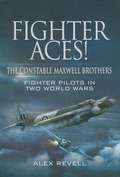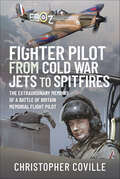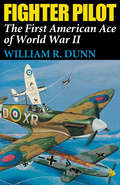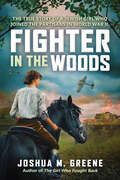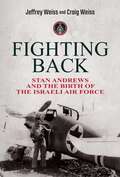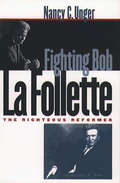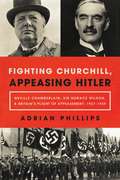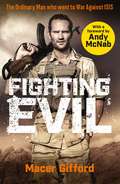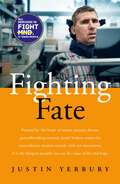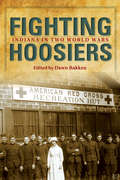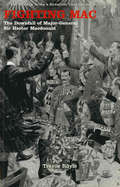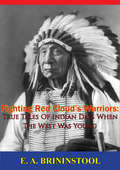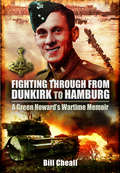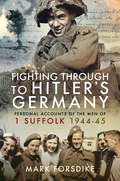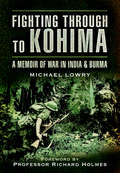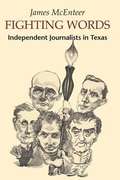- Table View
- List View
Fighter Aces!: The Constable Maxwell Brothers: Fighter Pilots in Two World Wars
by Alex RevellWhen Gerald Constable Maxwell was flying as a fighter pilot in World War I, his brother Michael was born. Both went on to have distinguished flying careers in World War II. This is the story of both men and how their paths crossed during the second conflict.Gerald served with distinction with 56 Squadron, one of the crack fighter units of WWI in France. Upon his return to England he became Chief Flying Instructor of No. 1 Fighter and Gunnery School at Turnberry. In World War II he served as Station Commander at RAF Ford, a night Fighter station near Arundel, one of the most efficient and happy stations in 11 Group.Michael followed in his brothers footsteps and joined 56 Squadron in April 1940 to fly the Hawker Hurricane. During May the squadron was moved to France to assist the fast retreating British and French forces as the Germans rapidly advanced. On 27 May, he was shot down whilst attacking ten Heinkel 111s on their way to bomb Dunkirk. Fortunately his first contacts upon landing by parachute were French and he managed to find his way to Ostend where he boarded a trawler and crossed the Channel back to Deal.56 Squadron had by now returned to their English base at North Weald from where they were flying patrols over the French coast and escorting RAF bombers raiding the German positions. On 8 June, whilst trying to reach returning Blenheims over Le Treport, the Hurricanes were bounced by Bf 109s and again Michael was hit, wounding him in the leg and foot, fortunately he eventually managed a crash landing back at North Weald. During the height of the Battle of Britain Michael was again forced to make a crash landing near Herne Bay which he was lucky to survive as his Hurricane had disintegrated around him.In the autumn of 1941 Michael was posted to 604 Nightfighter Squadron, led by the legendary Cats Eyes Cunningham flying Beaufighters and eventually Mosquitos. He was eventually to Command the squadron whose tally of enemy aircraft shot down when he left it had reached 100. This remarkable story includes first-hand combat accounts from both Michael and Gerald and the author has had access to the Constable Maxwells family records.
Fighter Pilot: The Extraordinary Memoirs of a Battle of Britain Memorial Flight Pilot
by Christopher CovilleA young boy sits in the back of a Chipmunk aircraft at RAF Woodvale, near Liverpool. He has never flown in anything before. As the power goes on and the little aeroplane soars into a clear blue sky, he decides at once that this is the only thing he wants to do in life: to be an RAF pilot. Fighter Pilot: From Cold War Jets to Spitfires tells the riveting story of how a boy from Liverpool, at the height of the Cold War, joined an RAF that was largely led by veterans of the Second World War. Christopher Coville arrived at the RAF College at Cranwell to find an environment shaped by English Public School traditions, but he made the grades needed to be streamed onto fighters, and went on to fly the Lightning, Phantom and Tornado F3 in the air defense role. Christopher eventually became station commander of RAF Coningsby and while in that role flew with the Battle of Britain Memorial Flight, becoming the only station commander to qualify on the Hurricane, Spitfire and Lancaster. He also qualified on helicopters and multi-engine aircraft and became responsible for the quality of the displays performed by the Red Arrows, flying with them regularly. Along the way, he steered the RAF’s biggest re-equipment programme since 1945 during a tour at the Ministry of defense and filling a challenging top NATO post during the wars in the Balkans. While this is a book about a young man from Liverpool who joined from grammar school and became a three-star Air Marshal, it is also, above all, a story written by a passionate aviator, whose affection for flying leaps out of every line, in a book which is full of excitement, deep knowledge of flying and affection for his fellow servicemen and women. But it is also a wonderful narrative about people, the great characters forged by military life, and honed by fear, exhilaration, and occasional tragedy. Fighter Pilot: From Cold War Jets to Spitfires is a unique perspective on aviation, written by a talented and dedicated pilot at the very top table of the RAF. This book culminates with his retirement, as the No.3 in the RAF, and being invited to have lunch with The Queen.
Fighter Pilot: The First American Ace of World War II
by William R. DunnThis WWII fighter pilot memoir recounts the author&’s many exploits as a flying ace during WWII in the Normandy invasions, the Battle for France and beyond. Born in Minneapolis in 1916, William R. Dunn decided to become a fighter pilot at the age of twelve. In 1939 he joined the Canadian Army and was soon transferred to the Royal Air Force. As part of the RAF&’s famous Eagle Squadron, Dunn was sent to Europe to fight in the Second World War. Flying Hawker Hurricanes and Supermarine Spitfires, he was the first Eagle Squadron pilot to shoot down an enemy aircraft. When he later transferred to the US Army Air Forces, he became the first American ace of the war. Lieutenant Colonel Dunn saw action in the Normandy invasion and in Patton's sweep across France. Twenty years later he fought again in Vietnam. In this lively memoir, Dunn keenly conveys the fighter pilot's experience of war—the tension of combat, the love of aircraft, the elation of victory, the boisterous comradeship and competition of the pilot brotherhood.
Fighter Pilot: The Memoirs of Legendary Ace Robin Olds
by Robin Olds Christina Olds Ed RasimusThe biography of American fighter pilot Robin Olds, who was a larger-than-life hero with a towering personality.
Fighter in the Woods: The True Story of a Jewish Girl who Joined the Partisans in World War II
by Joshua M. GreeneFrom award-winning author Joshua M. Greene (The Girl Who Fought Back; Signs of Survival) comes this remarkable true story of a Jewish girl in Nazi-occupied Poland who escaped near death to join -- and fight -- with the Soviet partisans in the woods. Scholastic Focus is the premier home of thoroughly researched, beautifully written, and thoughtfully designed works of narrative nonfiction aimed at middle-grade and young adult readers. These books help readers learn about the world in which they live and develop their critical thinking skills so that they may become dynamic citizens who are able to analyze and understand our past, participate in essential discussions about our present, and work to grow and build our future.The year was 1941, and Nazi Germany was bombing Poland. Celia Kassow, a young Jewish girl, knew she was in danger of being seized by the Nazis, so she ran to seek shelter at a Polish classmate's house. The classmate's response? "Get away from here, you dirty Jew."Celia and her family, like all the Jewish families in their town, were then imprisoned in a Nazi ghetto, facing daily starvation and torture. Most of Celia's family was murdered there, but a different Polish classmate of Celia's, a boy who had a crush on her, helped Celia escape to his family's farm, and eventually, into the woods to join the Soviet partisans.The partisans were resistance fighters who gathered in secret during WWII to fight back against the Axis powers by attacking German garrisons and blowing up trains. When Celia joined them, the other partisans -- mostly young men -- wanted to put her on kitchen duty, but Celia refused and asked to be put on patrol. She was given a horse, ammunition, and an assignment. Celia survived the war fighting with the partisans. After the war, she would go on to get married, have children, and immigrate to the United States, where she lived out her days assisting other immigrants and raising her family. Her true story, based on first-person testimony and vetted by Celia's son, is one of incredible bravery and grit in the face of unimaginable evil.
Fighting Back: Stan Andrews and the Birth of the Israeli Air Force
by Jeffrey Weiss Craig WeissFighting Back is the story of Stan Andrews, an assimilated American Jew and World War II veteran who became one of the first fighter pilots in the history of the Israeli Air Force.In 1948, Stan Andrews left a comfortable postwar life in Los Angeles to travel to the war-torn Middle East, where a four-front Arab invasion threatened to destroy the newly-declared State of Israel. There he joined the Israeli Air Force and became one of its first fighter pilots. Andrews was an unexpected volunteer for the fight for a Jewish state. He was many things—an artist, writer, assimilated Jew, ladies&’ man, pilot, and combat veteran of the Pacific War. He had previously been aloof from the struggle for Jewish independence but found himself so roused by the anti-Semitism of 1940s America that he decided to go to Israel and risk everything. Stan made the most of his time in Israel, serving in fighter and bomber squadrons and leaving his mark on an Israeli Air Force that has since become the stuff of legend.
Fighting Back: What an Olympic Champion's Story Can Teach Us about Recognizing and Preventing Child Sexual Abuse--and Helping Kids Recover
by Kayla Harrison Cynthia S. Kaplan Blaise AguirreTwo-time Olympic gold medalist Kayla Harrison has always been a fighter--yet as a young teen, no one knew she was also a victim. Combining Kayla's powerful story of sexual abuse by her judo coach with science-based information from two renowned therapists, this unique book provides critical guidance for parents and professionals. Learn how to spot the signs that a child or teen is being groomed, why kids stay silent about their trauma, how they struggle with self-blame and the brutal betrayal of a trusted authority figure, and exactly what kind of help they need to recover. No one is more qualified than Kayla and her expert coauthors to explain the impact of child sexual abuse--and what you can do to keep kids safe.
Fighting Blind: A Green Beret's Story of Extraordinary Courage
by Jim DeFelice Ivan CastroFighting was a practiced routine for Lieutenant Ivan Castro. But when a mortar round struck the rooftop of his sniper’s post in Iraq, he found himself in a battle more difficult than even he could have imagined. The direct hit killed two other soldiers and nearly claimed Castro’s life as well. Mangled by shrapnel and badly burned, Castro was medevac’d to Germany more dead than alive. His lungs were collapsed. He couldn’t hear. One eye had been blown out, the nerve to the other severed.In the weeks and months that followed, Castro would find that physical darkness was nothing compared to the emotional darkness of loss and despair. Desperate for a reason to live, he eventually fought his way back to health through exercise and a single-minded goal: running a marathon. Once he set his course, there was no stopping him. Stubborn to a point that at times bordered on insanity, he managed not only to recover but to return to active duty. Since 2007, he has run over two dozen marathons, including the Boston Marathon in 2013, where he was one of the runners diverted when the bombs exploded.Today, Castro helps prepare soldiers for combat, working exactly as if he were “sighted.” Fighting Blind, this frankly told account of his struggle through adversity, the highs and lows and the always bumpy road in between, is a story of hope and perseverance against the odds: an Unbroken for the present generation.
Fighting Bob La Follette
by Nancy C. UngerRobert "Fighting Bob" La Follette (1855-1925) was one of the most significant leaders of American progressivism. Nancy Unger integrates previously unknown details from La Follette's personal life with important events from his storied political career, revealing a complex man who was a compelling mixture of failure and accomplishment, tragedy and triumph.Serving as U.S. representative from 1885 to 1891, governor of Wisconsin from 1901 to 1906, and senator from Wisconsin from 1906 to his death in 1925, La Follette earned the nickname "Fighting Bob" through his uncompromising efforts to reform both politics and society, especially by championing the rights of the poor, workers, women, and minorities.Based on La Follette family letters, diaries, and other papers, this biography covers the personal events that shaped the public man. In particular, Unger explores La Follette's relationship with his remarkable wife, feminist Belle Case La Follette, and with his sons, both of whom succeeded him in politics. The La Follette who emerges from this retelling is an imperfect yet appealing man who deserves to be remembered as one of the United States' most devoted and effective politicians.
Fighting Churchill, Appeasing Hitler: Neville Chamberlain, Sir Horace Wilson, And Britain's Plight Of Appeasement: 1937-1939
by Adrian PhillipsA radically new view of the British policy of appeasement in the late 1930s, identifying the individuals responsible for a variety of miscalculations and moral surrender that made World War II inevitable. Appeasement failed in all its goals. The kindest thing that can be said of it is that postponed World War II by one year. Its real effect was to convince Hitler and Mussolini that Britain was weak and afraid of confrontation, encouraging them to ever-greater acts of aggression. The turning point of the Czech crisis in September 1938 came when Wilson saw Hitler on his own and left him convinced that Britain was bluffing and would not go to war to defend Czechoslovakia. The dismemberment of Czechoslovakia that followed was not the end of appeasement. The Anglo-German Declaration was Chamberlain’s personal vanity project but both Chamberlain and Wilson believed that it genuinely brought "peace for our time." Chamberlain and Wilson blindly pursued bilateral friendship between Britain and the dictators and ferociously resisted alternative policies such as working with France, the Soviet Union, or the U.S. to face down the dictators. They resisted all-out rearmament which would have put the economy on a war footing. These were all the policies advocated by Winston Churchill, the most dangerous opponent of appeasement. Churchill was a hated figure for Chamberlain and Wilson. They could not accept Churchill’s perception that that Hitler was the implacable enemy of peace and Britain, and opposing him became an end in itself for them. Churchill and Wilson had been bitter adversaries since early in their careers because of an incident that Fighting Churchill, Appeasing Hitler reveals publicly for the first time. Chamberlain had a fraught relationship with Churchill long before appeasement became an issue. Neither Chamberlain nor Wilson had any experience of day-to-day practical diplomacy. Both thought that the dictators would apply the same standards of rationality and clarity to the policies of Italy and Germany that applied in Britain. They could not grasp that Fascist demagogues operated in an entirely different way to democratic politicians. The catastrophe of the Chamberlain/Wilson appeasement policy offers a vital lesson in how blind conviction in one policy as the only alternative can be fatally damaging.
Fighting Evil: The Ordinary Man who went to War Against ISIS
by Macer GiffordA visceral, riveting, no-holds-barred military memoir told from the front line of the war against ISIS with a foreword by Andy McNab. In the summer of 2014 the world watched in horror as the black flag of ISIS swept all before it. Mosul, the second largest city in Iraq fell, ISIS proclaimed the caliphate and the horror mounted: from the mass murder, rape and enslavement of the Yazidis to the public beheading of journalists by British jihadis. For Macer Gifford it wasn't enough to ask why more wasn't being done, he knew he had to act. So, he left his job in the city, split from his girlfriend and a few weeks later found himself illegally crossing the border into Syria to join the Kurdish YPG in their fight against the savagery of ISIS.Macer Gifford became one of longest serving British International Volunteers and one of the only few to be promoted to be a Commander in the YPG. He fought alongside the Kurds (and their Syrian Allies) for three long tours of duty from the dawn of the caliphate all the way to its military defeat in the ruins of Raqqa in 2017, sniping at the final deadly wave of suicide bombers as they burst from the rubble. Along the way, he made - and lost - many friends. This is the only complete account of the war against the Caliphate by the Kurds and the remarkable and often eccentric band of international volunteers who fought alongside them.
Fighting Evil: The Ordinary Man who went to War Against ISIS
by Macer GiffordA visceral, riveting, no-holds-barred military memoir told from the front line of the war against ISIS with a foreword by Andy McNab. In the summer of 2014 the world watched in horror as the black flag of ISIS swept all before it. Mosul, the second largest city in Iraq fell, ISIS proclaimed the caliphate and the horror mounted: from the mass murder, rape and enslavement of the Yazidis to the public beheading of journalists by British jihadis. For Macer Gifford it wasn't enough to ask why more wasn't being done, he knew he had to act. So, he left his job in the city, split from his girlfriend and a few weeks later found himself illegally crossing the border into Syria to join the Kurdish YPG in their fight against the savagery of ISIS.Macer Gifford became one of longest serving British International Volunteers and one of the only few to be promoted to be a Commander in the YPG. He fought alongside the Kurds (and their Syrian Allies) for three long tours of duty from the dawn of the caliphate all the way to its military defeat in the ruins of Raqqa in 2017, sniping at the final deadly wave of suicide bombers as they burst from the rubble. Along the way, he made - and lost - many friends. This is the only complete account of the war against the Caliphate by the Kurds and the remarkable and often eccentric band of international volunteers who fought alongside them.
Fighting Fate
by Justin YerburyJustin Yerbury made a promise to his mother while she was dying of motor neurone disease (MND) that he would do everything he could to find a cure. MND had already taken several members of Justin's family, and he learned that they carried a rare genetic form of the disease that gave them a fifty-fifty chance of inheritance.Desperate to help his loved ones, Justin went to university to study science, eventually becoming a professor of molecular biology at the University of Wollongong and one of the world's leading experts on MND. While in New York, delivering a lecture on his groundbreaking research, Justin felt his thumb stop working - 'the beast' that had lurked so long in the shadows had caught up with him.Now 99 per cent paralysed and able to move only his eyeballs, Justin refuses to yield. With eye-tracking software, he has written his extraordinary memoir to shine light on this terrible disease and to show that, even in the bleakest of moments, there is always a reason to keep fighting.All proceeds from this book will be donated to Fight MND.
Fighting Fate
by Justin YerburyJustin Yerbury made a promise to his mother while she was dying of motor neurone disease (MND) that he would do everything he could to find a cure. MND had already taken several members of Justin's family, and he learned that they carried a rare genetic form of the disease that gave them a fifty-fifty chance of inheritance.Desperate to help his loved ones, Justin went to university to study science, eventually becoming a professor of molecular biology at the University of Wollongong and one of the world's leading experts on MND. While in New York, delivering a lecture on his groundbreaking research, Justin felt his thumb stop working - 'the beast' that had lurked so long in the shadows had caught up with him.Now 99 per cent paralysed and able to move only his eyeballs, Justin refuses to yield. With eye-tracking software, he has written his extraordinary memoir to shine light on this terrible disease and to show that, even in the bleakest of moments, there is always a reason to keep fighting.All proceeds from this book will be donated to Fight MND.
Fighting Hitler from Dunkirk to D-Day: The Story of Die Hard Jeff Haward
by Jeff Haward Neil BarberFighting Hitler From Dunkirk to D-Day is the compelling story of a man belonging to a group of which there are now very few survivors. Jeff Haward MM is a pre-war Territorial Army soldier who enlisted merely for something to do in the evenings. Consequently, he fought throughout the entirety of the Second World War. Jeff is a 'Die Hard', the historic name given to men of the famous Middlesex Regiment. He joined the 1/7th Battalion, a machine-gun battalion, equipped with the British Army's iconic Vickers medium machine gun.Following evacuation from Dunkirk, the 1/7th, while refitting and re-equipping, carried out coastal defence duties in preparation for the German invasion. So desperate was the situation that on sentry duty, the one rifle per section had to be handed to the next sentry, along with the only ammunition available three rounds!In 1941, they were attached to the famous 51st Highland Division. The less than enthusiastic welcome from the Jocks gradually evolved into respect following the Middlesex's performance at El Alamein and the subsequent campaigns in North Africa, Sicily, Normandy and North West Europe.Following the Reichswald battle, in March 1945, Jeff was surprised to hear that he had been awarded the Military Medal for bravery and was subsequently awarded the ribbon by none other than Field Marshal Sir Bernard Montgomery.Jeff Haward's experiences, those of a normal soldier, make fascinating reading and throw new light on the use of such Vickers gun battalions during the war.
Fighting Hoosiers: Indiana in Two World Wars
by Dawn E. BakkenFighting Hoosiers: Indiana in Two World Wars tells the compelling, heartbreaking, and breathtaking stories of some of the hundreds of thousands of Hoosiers who served their country during the First and Second World Wars. Drawn from the rich holdings of the Indiana Magazine of History, a journal of state and midwestern history published since 1905, the collection includes original diaries, letters and memoirs, as well as research essays—all of them focused on Hoosiers in the two world wars. Readers will meet Alex Arch, a Hungarian-born immigrant who was the first American to fire a shot in World War I; Maude Essig, a nurse serving with the American Red Cross in wartime France; Kenneth Baker, a soldier in the Army Signal Corps, who crawled across French fields (sometimes over and around dead bodies) to lay phone lines for military communications; and Bernard Rice, a combat medic who witnessed the liberation of the Dachau concentration camp in 1945. Indiana's brave men and women like these have served with distinction in the armed forces since the earliest days of the Indiana Territory. Fighting Hoosiers offers a compelling glimpse at some of their remarkable stories.
Fighting Infertility: Finding My Inner Warrior Through Trying to Conceive, IVF, and Miscarriage
by Samantha BuschSamantha Busch uses her voice to break the silence that surrounds the infertility community in this raw and relatable account of her journey with IVF, loss, and faith.Samantha Busch, wife of NASCAR champion Kyle Busch, knows the thrill of the racing circuit, but she also knows the heartache and despair of infertility. She shares both in this honest and relatable account where faith, family, love, and loss intersect. As Samantha&’s and Kyle&’s public lives grew more pronounced, their private life was being torn apart. The frustrations and uncertainty of their fertility problems took a toll on them as individuals and as a couple, creating a cyclone of emotions that threatened everything they had worked so hard for. Through these trials, they learned how to build a stronger relationship, foster a deeper faith, and find humor through the tears. They also discovered a passion for helping other couples gain access to fertility treatments. In this memoir, Samantha uses her voice to break the silence and stigma that surround the infertility community. She details her battle with infertility, including her IVF experience, her miscarriage, a failed cycle, and the overwhelming grief and depression that surrounded these obstacles. By sharing practical advice as well as candid and inspiring stories of her journey, she provides support, validation, community, and education for others experiencing similar tribulations. Fighting Infertility is an opportunity to feel understood, to gain strength through the struggle, and to ignite your inner warrior.
Fighting Mac: The Downfall of Major-General Sir Hector Macdonald
by Trevor RoyleOn a spring morning in 1903, Major-General Sir Hector Macdonald, one of Britain's greatest military heroes, took his life in a hotel room in Paris. A few days later he was buried hastily in an Edinburgh cemetary as his fellow countrymen tried to come to terms with the fact that one of Scotland's most famous soldiers had ended his life rather than face charges against his character.The suicide and its aftermath created a national scandal and one which still reverberates long after those dramatic events - it is now clear that the official files dealing with his case, the papers of the Judge Advocate have been destroyed. Macdonald or 'Fighting Mac' as he was known to an adoring public, was no ordinary soldier. A crofter's son who had risen from the ranks in the Victorian army, he covered himself with glory during a long and successful military career and in 1898 was widely acknowledged as the true hero of the Battle of Omdurman, which cemented British Imperial rule in Anglo-Egyptian Sudan. Everything lay at his feet - a knighthood, honours, the respect of fellow generals such as Roberts and Kitchener - but Macdonald's career came to a shocking full stop when he stood accused of homosexuality and was ordered to face a court martial. Unable to come to terms with the disgrace, he committed suicide. That should have been the end of his story but so powerful was the myth created by Fighting Mac that people refused to believe he was dead. Soon rumours were circulating that Macdonald had faked his death and had adopted the persona of a prominent Prussian officer, the future Field Marshal August con Mackensen, one of Germany's great leaders during the First World War. FIGHTING MAC tells the true story behind his disgrace and sheds new light on the myths....
Fighting Mad: One Man's Guerrilla War
by Michael CalvertMichael Calvert was one of the legendary figures of the Second World War. He hit the headlines as 'Mad Mike' after the first Chindit campaign in 1943, with a reputation as a tough and daring leader of guerrilla troops. He was one of the first men selected for the Chindits by the controversial General Orde Wingate. He became Wingate's right-hand man - both in fierce jungle fighting and in battles against stick-in-the-mud staff officers. His speciality was penetrating behind enemy lines. Mad Mike fought in the snow and ice of Norway, in the steaming jungles of Burma, and on the battlefields of Europe where in 1945 he commanded the crack Special Air Service Brigade.
Fighting Red Cloud’s Warriors: True Tales Of Indian Days When The West Was Young
by E. A. BrininstoolTHE winning of the West was no child's play! It was war--war of the most brutal and inhuman type on the part of both Indians and whites. The Indian was fighting for his home, his commissary, his lands--lands ceded him through solemn treaty with the United States government--and what man, of any nation (if he is any sort of man) will not fight "for home and native land"?The white man fought to advance the cause of civilization, irrespective (in most instances) of the rights of the Indian, and without regard to his future existence. Civilization won--and to civilization's shame, it was at the cost of unnumbered thousands of lives and the shedding of much human blood of both whites and reds.I am not a believer in the old adage that "the only good Indian is a dead Indian." My sympathy is with the red man. The early white traders who trafficked with the Indian were, as a rule, a class of men of little conscience and few scruples, who would stoop to any deceit or trickery to rob the Indian of his furs and pelts. It was the early trader who introduced whiskey among the Indian tribes; who, through fraud and knavery, turned the red man against the whites of whatever class. This was the beginning of the hatred and contempt which made all white men, good or bad, soon look alike to the warring savage.In this volume of the "Frontier Series" I have written of a few of the most noted battles between the red man and the white man. As in the previous volume, no fiction is employed in these pages. Every incident related actually occurred, and is a part of the history of the old West. Some biographical sketches of noted frontier characters are included. The chapter on the destruction of the buffalo may well make the present-day sportsman pause and reflect.
Fighting Through from Dunkirk to Hamburg: A Green Howard's Wartime Memoir
by Bill CheallA British infantryman shares his harrowing story of life on the frontlines of WWII, from the North African Campaign to the invasion of Germany. In April 1939, when Bill Cheall joined the famous Yorkshire infantry regiment known as the Green Howards, he could not have imagined the drama, trauma, rewards and anguish that awaited him. But he recounts it all here, in this vivid memoir of service and courage under fire. As a Green Howard, Cheall was on the receiving end of the Nazis' Blitzkrieg and was evacuated exhausted. Then, courtesy of the Queen Mary, he shipped off to North Africa as part of Field Marshal Bernard Montgomery's Eight Army. After their victory in Tunisia, Cheall went on to the invasion of Sicily. The Green Howards then returned to England to be in the vanguard of the Normandy Landings on Gold Beach—where Cheall was wounded. Once he recovered, Cheall returned to the war zone and finished the war as a Regimental Policeman in occupied Germany. It is a remarkable story told with modesty, humor, and an eye for detail.
Fighting Through to Hitler's Germany: Personal Accounts of the Men of 1 Suffolk 1944–45
by Mark Forsdike&“The real story of how the Second World war was won in Europe . . . Packed with the personal stories of the men who were there.&” —Clash of Steel After landing on D-Day, 1st Battalion, The Suffolk Regiment fought through France, Holland and into Germany as part of the 3rd (British) Infantry Division. Ever cheerful, the Battalion were opposed by an increasingly ruthless enemy determined to deny the invader their homeland. As the campaign developed, 1 Suffolk acquired an enviable reputation for getting the job done with the minimum of fuss. Inevitably casualties mounted up and, of the 850 who landed on D-Day, just 178 were still serving on VE-Day; 215 had been killed and 640 wounded. The Battalion&’s success was due in large measure to fine leadership and all four commanding officers went on to enjoy distinguished careers. But without the stalwart fighting spirit and comradeship of all ranks none of the Battalion&’s achievements would have been possible. This fine book draws on the testimonies of officers and men who served in this historic campaign. Recognition of the fighting record of 1 Suffolk is long overdue and the author is to be congratulated for pulling together these inspiring first-hand accounts along with many previously unpublished photographs.A Soldier Magazine Top Read of the Year&“Brings life to the story of in this case World War II, and gives an insight into what this war was like. The author deserves praise for the way he has presented the words of these men, as it makes for a very engaging read.&” —Armorama
Fighting Through to Kohima: A Memoir of War in India and Burma
by Michael LowryA decorated British officer&’s wrenching and inspiring firsthand account of the worst battle of the Burma campaign. Lt. Col. Michael Lowry MC MBE, was awarded the Military Cross for his role in the desperate defensive action at Kohima, considered the worst of the campaign in Burma. After joining up in 1939 with the Queen&’s Royal Regiment, Lowry was posted to the North West Frontier of India, where he cut his teeth chasing gangs of Pathan bandits for two years. As the Japanese advanced into Burma, Lowry found himself fighting in the Arakan region, where his battalion was cut off by the Japanese for three weeks. Having survived that, next came the action at Kohima—where in the course of one week Lowry&’s battalion lost 173 members. Lowry was seriously wounded in the conflict but fortunately lived to tell the tale. This is a fascinating and inspiring book, one of the most action-packed memoirs of the war in Burma ever published.
Fighting Words: Independent Journalists in Texas
by James Mcenteer"Fighting Words profiles five journalists who published the truth as they saw it, no matter how their reporting angered politicians, social and religious leaders, or other journalists. " "The five journalists are William Brann (1855-1898), Don Biggers (1868-1957), John Granbery (1874-1953), Archer Fullingim (1902-1984), and Stoney Burns [Brent Stein] (1942- ). Though they lived in different eras, all these men dealt with issues that society continues to face - racism, official corruption, religious freedom, educational reform, political extremism of the left and right, the clash of urban and rural values, and the fear of change. Their lives and work constitute a unique alternative perspective on Texas history and the history of journalism itself. " "In addition to the troubling questions they raised on social issues, these independent journalists challenge us, as they challenged the mainline media of their own times, to define the function of journalism and to examine the mandate of the First Amendment. We may doubt the wisdom of some of their convictions, but not the courage they needed to express them in the face of ridicule, hostility, intimidation, and even death. More than the specific causes they fought for, the independents' passion for truth and their absolute belief in free speech constitute their greatest legacy to us and to journalism. "--BOOK JACKET. Title Summary field provided by Blackwell North America, Inc. All Rights Reserved
Fighting Words: The Bold American Journalists Who Brought the World Home Between the Wars
by Nancy F. CottFrom a Harvard historian, this riveting portrait of four trailblazing American journalists highlights the power of the press in the interwar period. In the fragile peace following the Great War, a surprising number of restless young Americans abandoned their homes and set out impulsively to see the changing world. In Fighting Words, Nancy F. Cott follows four who pursued global news -- from contested Palestine to revolutionary China, from Stalin's Moscow to Hitler's Berlin. As foreign correspondents, they became players in international politics and shaped Americans' awareness of critical interwar crises, the spreading menace of European fascism, and the likelihood of a new war -- while living romantic and sexual lives as modern and as hazardous as their journalism. An indelible portrayal of a tumultuous era with resonance for our own, Fighting Words is essential reading on the power of the press and the growth of an American sense of international responsibility.
